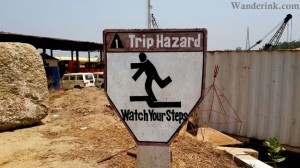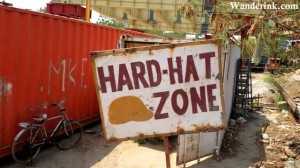Looking for pusta # three-and-half
Most direction-giving is associated with landmarks. Hence the parlance here changes with topography. While the Metro introduced the ‘pillar’ as a driver marker over a decade ago, the ‘pusta’ remained confined to civic suburbia. But as cities become one nonstop conurbation with the south segueing into the southwest into the northwest into the north the pustas have come closer to urban living. But what indeed is the pusta? Heading for a shoot from Dwarka in southwest Delhi to Wazirabad along the northern fringes, a pusta was where we had to make the final turn. From my crew members to cabbie, everyone had their own takes.
“It’s a kind of road, uneven, a case of missed tarring,” said an assistant taking his cues through the window. “Like cows have right of way in the cities in pustas it is buffaloes.”
“Pusta…pusta…” the cabbie trailed off like an arcanist under duress. “Which number are we looking for?”
A pusta is broadly an embankment – which makes it mandatory for a river to be in the general area. Though not much of one during summers the Yamuna traces a path of rending strife through Wazirabad. The earliest migrants to Delhi encroached upon the riverbed or reclaimed land which they bought from local farmers. As the river flooded during monsoons they resettled into higher areas on both banks which led to the growth of the jhuggi clusters. (Though still known as jhuggi slums, they are hardly ‘jhuggi’ anymore, meaning ‘built of mud and corrugated iron’ but are houses proper, many several floors high.) The pusta along this stretch of the Yamuna looked like one long jhuggi some with garish lemony green facelifts, precarious towers leaning over service lanes. Hunting decent breakfast joints here is like looking for onions in Jain sambar. One morning blinded by hunger we waited outside a four-bench restaurant for a full two hours before the guy whipped up oil-clogged bread pakoras – served with cold mint chutney from the refrigerator. Then too, the first one went to Hanuman whose gaze didn’t stir even once from the Dronagiri he held aloft.
Locals say there was a lot of beautification done for the Commonwealth Games of 2010 for which many families – and businesses – had to be uprooted.
“All the jhuggis were moved to resettlement colonies elsewhere,” one said.
Remarkable as it was incredible I looked around: once you step behind the beautiful forevers cleaving a jhuggi from the rest was nothing short of divination.
“Can you tell us the way to pusta…number…” my cabbie asked the hotel manager before turning to me for the number. I referred my phone and said ‘three-and-half.’ The cabbie laughed thinking I was pulling his leg.
“It is between pusta number three and four,” the manager replied.
The cabbie looked around now not knowing whether to laugh or not.
Now the rest of us laughed.
Haywire helicam
I with my DOP have clung on to suspended crane baskets – and not manbaskets, even – and cavorted up cell phone towers for that one all-encompassing shot from the air. Helicams/drone cameras have been buzzing around for a few years now like an answer to a prayer I never had – for cameras attached to multiple rotors was beyond my limited capacity technical brain. Since their advent anyway I have been an ardent user and die-hard adulator at the marvel it is. As with most electronic products today the leader producer is a Chinese firm, DJI. Their Phantom series have captured the prosumer market and with the recent Phantom 4 – which I am yet to shoot with – they are at the undisputed top.
Nothing much I can do save gawk when it just zips upward with its payload – the camera and the batteries. When I began shooting with drone cameras the flight time was less than 15 minutes due to small size batteries; today it is a full 25 minutes. Both Phantoms 2 and 3 are marked improvements over the Inspire with improved stability outdoors, downward facing cameras and high speeds up to 60 kmph making it suitable for fast tracking shots. The photo quality just gets better with each passing model, 4K resolution being a standard, with the P3 even provisioning to compose the shoot. Before you say I gush too much I will come to its most awe-inspiring feature – the different modes like intelligent orientation, point of interest and the most useful one, the home lock – which brings it back to wherever it took off, however high and far it has wandered.
The controlling is done through instruments that look like gaming consoles to tablets and even smartphones. While the failsafe mode allows for foolproof homecoming there have been occasions where the signal between the drone and the controller got cut off leading to crash landing. A high chance of this occurrence is at construction areas with all the high power electrical lines lying around resulting in a lot of electromagnetic interference. We lost one P3 at a bridge site bustling with high voltage lines and machinery. My sedulous operator lost signal, the visual contact was already lost in the smog which prevented his even bringing it down manually.
Watching the final footage of a crash landing drone is crazy: dropping altitude quickly they end up getting sucked into the wash of their own propellers which make it spin wildly and crash through boles. Sometimes you can also see birds turn around in a jiffy and flutter away cackling.
Emma, my love
The earliest cranes were built by the ancient Greeks, dating back to 6th century BC, and see how they fared. Now if they had access to Liebherrs or the Thialf – a crane so big it’s a ship by itself – we’d just have more world wonders. While there are Gottwald truck cranes and gantry cranes of different capacities on site, the star attraction is the 1250 ton Terex Demag CC 8800 lattice boom crawler, nicknamed Emma. I love grand old dames and Emma is the grandest of them all. She sits on elevated ground with a bearing capacity specially done up to 30 tons metres square. While the elevation is a precaution from the heavy flooding witnessed along the Yamuna during monsoon it gives it a standoffish appearance, its nose already in the air. If they hadn’t named her Emma, I’d call her Maggie Smith.

















Right. I know Maggie Smith. The rest? Perhaps when you write in English 🙂
Its a man’s world, my dear… I mean, its a construction site.
But where is Emma? Was so looking for her pic. Sob! Sob!
Jokes apart, Extremely interesting read, especially the technical bit which usually sounds Greek to me. Muchos gracias!
I remember the uprooting of one such settlement from Pushta to Bawana and we were so shocked that after our long protesting letters to the then CM we were allowed to work in Bawana for a solid waste management intervention for a year and a half. Wonder what is the state now.
Thank you, Pragya. Settlement uprooting keeps happening all over Delhi, all the time. Bawana maybe you can find out from the MCD or Toxics Link, perhaps. :))